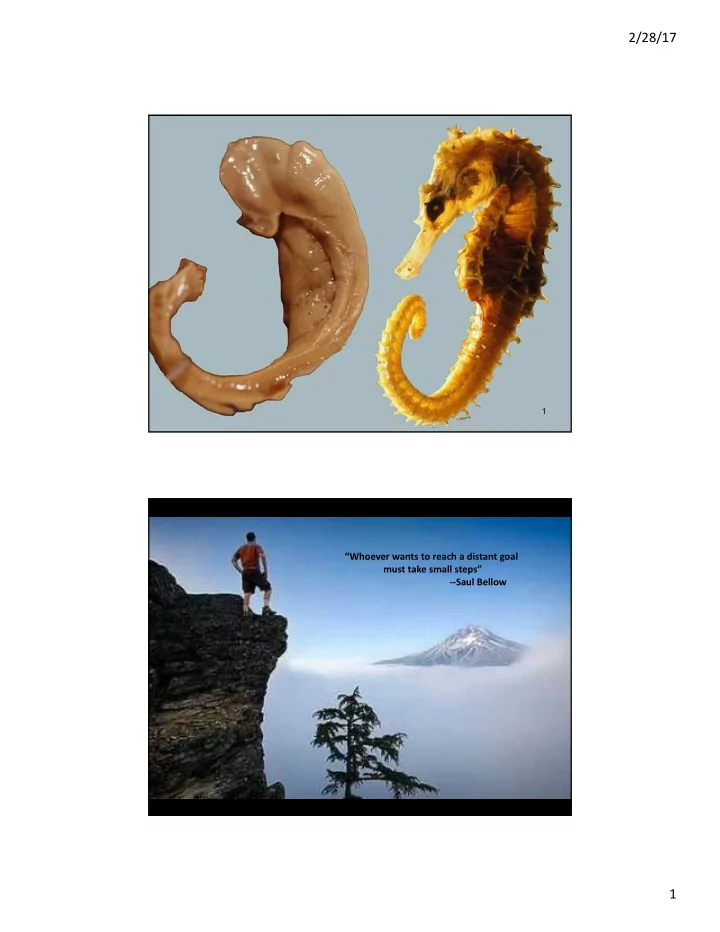

2/28/17 1 “Whoever wants to reach a distant goal must take small steps” --Saul Bellow 1
2/28/17 Neural Navigation I: constructing a cognitive map of space 1. Intelligent navigation: getting from here to there 2. A place hierarchy in the brain 3. Functions of the hippocampus A. Representing space and spatial memory B. Memory consolidation Where things are: coordinate frames • Egocentric frame of reference: represents where things are relative to a specific part of my body (e.g. retina, trunk of body, hand) • Allocentric frame of reference: represents where things are relative to fixed landmarks or boundaries. 2
2/28/17 Conclusions from Grandmother Cells • Some medial temporal lobe neurons exhibit responses to individuals, places, or objects that are – Sparse: few cells respond to any given image – Selective: each cell seems to respond to a specific concept or category – Invariant: these cells respond regardless of the current appearance of the individual • Sparse conceptual (abstract) representations may facilitate encoding specific memories and associations How to get where you want to be 1. identify landmarks : what is this? 2. use landmarks to determine position and heading : where am I and which way am I pointing? 3. access memory of spatial relationships between landmarks and goal: where are other relevant places? 4. plan route …and go! 3
2/28/17 Three strategies to get from here to there • Path integration : count steps in correct direction, e.g. in the dark. • Perform memorized series of steps/decisions : turn left at landmark X then right at Y. • Represent position on a cognitive map of remembered places to guide your movement. Neural Navigation I: constructing a cognitive map of space 1. Intelligent navigation: getting from here to there 2. A place hierarchy in the brain 3. Functions of the hippocampus A. Representing space and spatial memory B. Memory consolidation 4
2/28/17 Translating between two egocentric coordinate frames Parietal cortex represents where things in my visual field are, relative to me 5
2/28/17 How to get where you want to be 1. identify landmarks : what is this? 2. use landmarks to determine position and heading : where am I and which way am I pointing? 3. access memory of spatial relationships between landmarks and goal: where are other relevant places? 4. plan route …and go! Para-hippocampal Medial temporal lobe Retrosplenial complex place area Hippocampus Identifies landmarks Uses landmarks to Encodes a cognitive map determine the current that represents landmarks location and direction and goals in terms of their coordinates in allocentric space 6
2/28/17 scenes > objects These areas encode scene category and landmark identity Multi-Voxel Pattern Analysis: A classification algorithm 7
2/28/17 Parahippocampal Place Area identifies the current scene/place RetroSplenial Complex locates and orients the current scene in the larger space around it 8
2/28/17 t Scanned while viewing images taken at n different locations on a familiar college campus fMRI evidence that RSC codes location in a manner that abstracts away from perceptual features Pattern similarity 9
2/28/17 Hippocampus (MTL) represents locations on an allocentric cognitive map 10
2/28/17 fMRI evidence that the human hippocampus encodes distances: a key feature of a cognitive map 11
2/28/17 Division of labor Parietal: Where are things relative to me? (ego) RSC: Where am I and which direction am I facing? Hippocampus: (allo) Where are other places? PPA: what is this? Three strategies to get from here to there • Path integration : count steps in correct direction, e.g. in the dark. • Perform memorized series of steps/decisions : turn left at landmark X then right at Y. • Represent position on a cognitive map of remembered places to guide your movement. 12
2/28/17 Spatial navigation vs. sequence of stimulus-response steps/decisions Spatial strategy: hippocampus Non-spatial strategy: striatum Iaria et al 2003 Striatum: Motor skills and habits, Procedural Memory Striatum = two elements of basal ganglia: – Caudate nucleus – Putamen 26 13
2/28/17 Neural Navigation I: constructing a cognitive map of space 1. Intelligent navigation: getting from here to there 2. A place hierarchy in the brain 3. Functions of the hippocampus A. Representing space and spatial memory B. Memory consolidation Fig. 24.9 28 14
2/28/17 Hippocampus! 29 From JH Martin, Neuroanatomy 30 15
2/28/17 31 Morris Water Maze HP lesion à can’t remember where the platform is à spatial memory 32 16
2/28/17 33 34 17
2/28/17 35 36 18
2/28/17 37 38 19
2/28/17 Hippocampal place cell 40 Hippocampal place cells 41 20
2/28/17 Grid cell 42 Grid cell in entorhinal cortex 43 21
2/28/17 Head Direction (HD) cell 44 45 22
2/28/17 46 47 23
2/28/17 48 49 24
2/28/17 Place cells recorded in human hippocampus! 50 Boundary cell 51 25
Recommend
More recommend